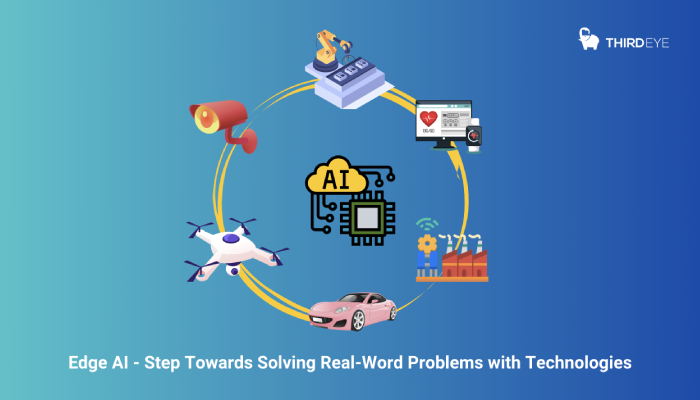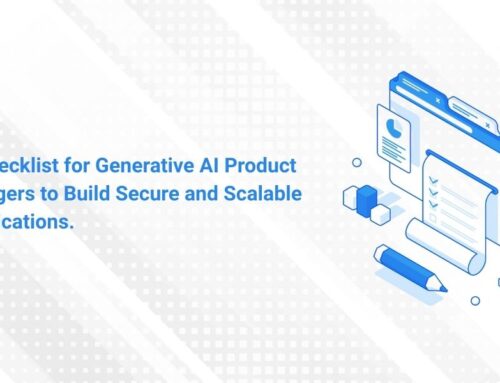Significance and Applications of Edge AI
“Edge AI : Designing Today & Future”
In the era of rapidly growing & changing AI technology day by day, we need a solution to cater the immensely large data produced by small devices, mobile computing and the Internet of Things (IoT) when used in network. Management of this vast amount of data is challenging task without compromising performance and latency is a complex puzzle that requires optimized solutions. So, Here the AI edge comes into the picture!
The Emergence and Understanding of Edge AI
AI edge, or Edge AI, is a technology that moves Artificial Intelligence (AI) processing closer to the source of data, or “the edge” of the network, rather than relying on a central cloud. This means that tasks and decisions can be made quickly in real-time and with use of less bandwidth. It makes AI faster, more reliable, and secure.
It is a system that uses artificial intelligence technologies to process data. Instead of sending data back and forth to the cloud for processing, Edge AI performs data processing on the device itself. This system is popular in devices that need to work independently and promptly, such as smartphones, drones, robotic devices, self-driving cars, security cameras because it can process data quickly, securely, and with less bandwidth. The growth and development of edge AI applications have been fuelled due to internet revolution around the world turns into the rapid growth of big data and the Internet of Things (IoT).
What is Edge AI?
The term ‘Edge AI’ was coined to emphasize the integration of Artificial Intelligence models with edge computing techniques. This involves computing or processing the data at the user end or at the point of creation.
This ability to process data using some sort of AI processor leads to the following consequences:
Significance of Edge AI
– Eliminate redundant and non-valuable data at the seed level. Leading to improved bandwidth efficiency
– As the data is processed locally before being sent to a cloud or any storage archive, it significantly reduces latency and leads to faster data accessibility.
– Edge AI increases security and privacy concerns as it keeps the data at the device level and only sends it to the storage medium if necessary.
– Due to the above significances, the added advantage is reduced costs as the data entering the cloud is highly processed and minimal compared to the data at the point of generation.
-It also increases the reliability factor as the AI models do not need to communicate with cloud architectures. Data processing is costlier and requires reliable internet, which is most likely not possible in the environment where the device is placed at remote locations, this challenge can be tackled by Edge AI.
Applications of Edge AI
Security Cameras:
Security cameras generate a substantial volume of data on a continuous basis, spanning minutes, hours, and days. This data is predominantly in video format, resulting in significantly larger file sizes compared to other sensor-generated data.
To mitigate these issues, Edge AI is employed. With this paradigm, cameras are endowed with autonomous processing capabilities. They continuously generate data in smaller, more manageable chunks through processes like object detection, image/frame classification, pedestrian detection, and Optical Character Recognition (OCR) for discerning vehicle number plates of those infringing traffic regulations.
The cameras process this data at the edge device level, intelligently discarding extraneous information. Only pertinent data is forwarded to the server or designated storage medium, such as cloud storage. This streamlined approach substantially reduces payload sizes, resulting in a multitude of benefits. These include lower latency, less bandwidth usage, which in turn facilitates the integration of additional applications within the existing bandwidth allocation. Furthermore, it leads to reduced storage costs, heightened reliability, and mitigated privacy and security risks.
Intelligent Home Appliances:
The home appliances like Smart Speakers, Smart thermostat, etc. all of these devices process the generated data at the edge device level.
like – Smart Speakers – These employ edge AI to interpret the voice messages or the speech locally not depending solely on the cloud architecture.
Manufacturing Robots:
Robots in the factories use Edge AI to adapt to different tasks, analyse machine health in real-time, and predict maintenance needs, reducing potential downtimes.
Retail Analytics Systems:
These systems use Edge AI to analyse customer behaviour in real-time, enabling personalized marketing and real-time inventory management.
Mobile Healthcare Applications:
In mobile healthcare applications, Edge AI enables real-time monitoring of vital signs, such as heart rate and blood pressure, using wearable devices. This allows for immediate health insights and alerts, enhancing patient care and well-being while minimizing the need for constant connectivity to a central server.
Drones for Agricultural Monitoring:
Drones equipped with Edge AI technology navigate and analyse farms, identifying areas that need water, fertilizer or pest control.
Overcoming the Challenges of Edge AI
The shift to Edge AI has not been smooth sailing entirely, especially when considering the deployment of AI models. Edge devices require a balance between model complexity and device functionality making the implementation of AI models on such devices is a tough task.
Model Compression Methods
Model compression techniques, including pruning, quantization, knowledge distillation, low-rank matrix factorization, and hashing, are widely applied to optimize neural networks in edge devices.
Model compression methods, can provide the much-needed relief. It reduces the size of the AI models without impacting on performance, maintain smooth operations even on smaller devices.
Brief on Challenges & Solutions of Edge AI
Limited Computational Resources: Some devices have limited processing power and memory.
With Edge AI, Optimizing AI algorithms for minimal resource usage and develop specialized edge AI hardware for better performance is possible. Quantization technique can be used to reduce the memory size.
Model Size and Complexity: Edge AI models must be small yet accurate.
Employing model compression techniques and quantization will reduce model size while maintaining functionality.
Power Consumption: Running AI models can drain battery life quickly.
Implementation of power-efficient hardware and software optimizations, like low-power processors and sleep modes could be implemented.
Real-Time Processing: Some applications demand low-latency processing.
Real-time performance can be achieved using edge AI accelerators and optimizations.
Data Privacy and Security: Processing sensitive data on devices has privacy and security risks.Edge AI application of on-device data encryption, secure enclaves, and decentralized processing to enhance security and privacy.
Model Training and Updates: Training and updating models on edge devices can be complex. Implementation of federated learning and over-the-air (OTA) updates to train and update models efficiently can be done without compromising device performance.
Scalability and Manageability: Managing a large number of edge devices is challenging.
Device management platforms and cloud-based solutions can be used for efficient deployment, updates, and monitoring.
Edge-to-Cloud Integration: Integrating edge devices with cloud services efficiently is a complex task. Implementing edge-to-cloud communication and hybrid AI solutions will balance cloud resources and local processing effectively.
Addressing these challenges requires a combination of hardware innovation, software optimization, and the adoption of best practices in Edge AI development and deployment. The specific solutions will vary based on the application and the constraints of the edge devices.
How we can implement a better Edge AI solution with ThirdEye?
At Third Eye, we can enhance Edge AI solutions by focusing on creating compact, efficient algorithms that are capable of self-learning and decision-making. Our team, armed with extensive experience in AI-driven technologies, LLMs, GPT models aims to provide high-speed performance and real-time analytics. We believe that with our vast knowledge and innovative approach, we can deliver superior outcomes in Edge AI solutions, ultimately aiding in harnessing the potential of artificial intelligence to its full extent.
Furthermore, we focus on continual learning and adaptation to enhance our solutions. With Third Eye, you partner with a forward-thinking organization that makes the most of Edge AI to drive your business progress.
Conclusion
Finally, The Edge AI is a ground-breaking innovation with the ability to drastically alter our daily activities, industries, commercial environments, and our overall economy. The power of Edge AI lies in its capacity to facilitate immediate, efficient and secure functions, making it an invaluable tool in today’s digitized world. Using Edge AI means moving towards a setting that relies less on online storage, makes decisions faster, and is more suited for the future. This advanced technology urges us to explore, evolve, and tap into its unmatched potential as we prepare ourselves for a future filled with countless possibilities. From our offices to our homes and our cities at large, Edge AI is anticipated to redefine our interactions, operations, and lifestyles.









